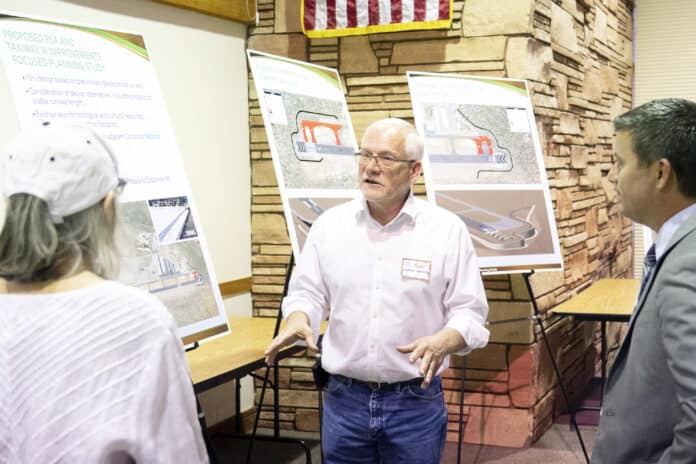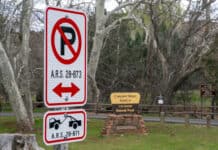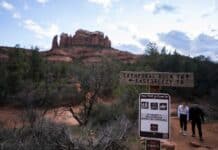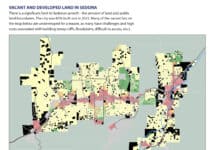
The Sedona Airport will be moving forward with plans for a $40 million runway safety project with funding from the Federal Aviation Administration, the Arizona Department of Transportation and the Sedona-Oak Creek Airport Authority.
“The proposed project would provide standard runway safety areas … including constructing retaining walls at each end of the runway to allow the installation of EMAS [engineered materials arresting system] beds,” a SOCAA press release explained. “The airport’s parallel taxiway, taxiway A, would be improved at the same time, as well as other minor taxiway geometry and related drainage and perimeter fence improvements.”
Airport manager Ed Rose said that the expenditure of $40 million is necessary to bring the airport up to “the instructional standards for this classification [D2] of airport.”
“The RSA project is a safety area project,” Rose said. “They’re safety enhancements to the airport, and they’re life and property saving improvements, in that order. We have a history of aircraft going off the end of the runway and we’re taking steps to prevent that from happening again.”
Rose was unable to specify the number of fatalities that have occurred at the Sedona Airport, as the most recent fatal incidents took place a decade ago, prior to his tenure.
SOCAA plans to spend the year examining possible upgrades, which will be followed in 2024 by a full environmental assessment under the National Environmental Policy Act with the FAA and the Coconino National Forest. Project design will follow during 2025- 26 and construction should begin in 2027.
Rose said that most of the comments SOCAA received during its open houses were positive, with residents’ major concern appearing to be effects on the viewshed from the construction of the proposed retaining walls. Some residents have proposed adding greenery at those locations or selecting paints to camouflage the walls.
The airport has already engaged the Scottsdale firm of Coffman Associates to conduct a preliminary analysis on the visibility of the proposed walls and has awarded it an extension of its $479,592 contract for services through the end of the year.
Viewshed
The area’s topography should hide the 35 to 40-foot high retaining wall from the sight of neighborhoods to the southwest of the airport, but it will be most visible from the Airport Mesa vortex as well as some of the homes on the north side of the runway.
“We don’t know exactly what kind of surface treatment it will have,” Coffman Associates environmental planner Judi Krauss said.
“But the idea would be to blend it in the landscape as much as possible. You won’t be able to see any of the walls from [State Route] 179 as near as we can tell. This is our preliminary analysis. [The] FAA will require full environmental assessments probably next year, and then we’ll be revisiting.”
The airport claims that the retaining wall is needed for several reasons, such as preserving the stability of the runway safety area, and that it “will be designed to accommodate the weight of aircraft that might overrun the runway and emergency service vehicles,” according to the airport’s 2017 master plan. The cost estimate for this construction was $7.1 million, with about 91% of the funding coming from the FAA, 4.5 % from ADOT and 4.5% from local contributions.
“You have to have that distance for the safety area and we don’t,” Rose claimed. “There’s no way to create it other than a massive fill project that would be an eyesore for everybody, and awfully expensive [and] not practical.”
Carrier Style
The other main infrastructure component addressed during the open houses was the proposed installation of engineered material arresting systems, in part to address the small number of previous fatalities at the airport.
EMAS is recommended by the FAA for airports that have reduced space for aircraft that undershoot or overshoot the runway. Rose compared it to a runaway truck ramp because it arrests the forward movement of an aircraft. The system will involve the installation of specially-designed crush- able material at the end of the runway, which will allow aircraft tires to sink into it. Rather than extending the runway, these modifications will require it to be slightly shortened.
The perimeter fence will also be modified because the current fencing and vegetation is an obstruction per FAR Part 77.
“In other words, it penetrates the runway surface elevation within a certain proximity of the runway,” Rose said. “That’s a safety issue. That’s got to be moved to below the runway grade at a minimum, and the fence will be relocated around the toe of the proposed retaining wall, and we will work to mitigate the impact to the trail.”
Land Use Considerations
SOCAA will be requesting that an additional 2.6 acres be added to its original U,S, Forest Service lease, which will be a six- to seven-year process that will not hold up airport improvements.
The authority still has to go through its NEPA assessment and will then have another public information session to satisfy that federal requirement before moving forward with its design phase, assuming there are no unfavorable findings for the project.
“We don’t anticipate any but it is the mesa, we know that there were Native American dwellings up there, gardens up there. We know there are chert piles … where they knap[ped] the rock down to arrowheads and you can see a bazillion chips around,” Rose said.
Sustainability
Other infrastructure projects at the airport are in the works. Currently SOCAA is working with Arizona State University to do an energy and water audit to reduce resource consumption and explore how the airport can be ready for the adaptation of electrification in the industry.
“Some of the aircraft in development now require a megawatt of charging capacity,” Rose said. “I’m not sure that exists here in Sedona for us to take advantage of. We’re examining the lights to see what can go LED versus fluorescent. We’re looking at the motors on all of our hangars to see if there’s something more energy efficient; all of the furnaces and cooling systems will be examined.”
Water catchment systems that could save 100,000 to 150,000 gallons of water annually are another possibility.
“We need water up here on the mesa,” Rose said. “Fire suppression water is never a bad thing. Having an additional water source in the middle of Sedona is certainly a good thing long-term.” Another taxiway is being designed south of the Sky Ranch Lodge, a maintenance building will be designed this year and the automated weather observation system is being replaced at a cost of $400,000.
The airport is scheduled to be closed to fixed-wing aircraft between Monday, June 5, and Wednesday, June 14, for construction; this will not affect helicopters.
Additional public comment on the proposed RSA projects may be directed to Judi Krauss of Coffman Associates at (602) 993-6999 or jkrauss@coffmanassociates.com





















